Captain Horace N. Heisen, ca. 1919
(Source: Chellis)
 |
Captain Horace N. Heisen was born February 9, 1893 at Oakland,
CA. He attended Oakland High School where he was a
track star. He attended the University of California,
Berkeley for two years and the Hastings College of Law for
three years, receiving the degree of Bachelor of Laws. While
at college he was an outstanding athlete and excelled in
the major sports, being particularly noted as a baseball
pitcher.
For two years he practiced law, and then enlisted in the
Aviation Section, Signal Corps, June 12, 1917. He received
his flight training at Rockwell Field, CA and was rated Reserve
Military Aviator, October 19, 1917. He accepted a commission
as 1st Lt. January 1, 1918 and was sent to France with the
50th Aero Squadron on February 22, 1918. On March 21
he was assigned with Flight “B”, 99th Aero Squadron,
and served with this organization on the front lines until
August 12, 1918. On June 26th while on a reconnaissance
flight seven miles over enemy lines he was shot down by anti-aircraft
fire. But, due to skillful piloting, he landed his
plane successfully a half mile behind Allied lines.
Image, left, is a formal military portrait taken at the
studios of Harris & Ewing, approximately August, 1919. His
grandson notes, "In records I have reviewed I have noticed
his middle name is occasionally also spelled 'Neveil'. In
family discussions I have come to learn that the name 'Neveille'
was of French origin and given to him to honor the maternal
side of his progenitors."
After the Armistice, his grandson says, “His squadron
was assigned to the US Third Army for occupation duties. During
this time period his duties apparently included ‘testing’ and
reporting on other countries aeroplanes for the War Department
for one of his flight logs has an extensive list of hours
flown in foreign planes.”
He was assigned commanding officer of the 278th Aero Squadron
on September 13, 1918 and served with this organization to
July 22, 1919. He was promoted to Captain October 3,
1918. Upon return to the U.S., he was honorably discharged
at his own request November 10, 1919.
Now, below, comes the 278th Aero Squadron assembled. This
rare image came from the garage of Mr. Chellis' mother in
California. It is presented vertically because it would be
too small to see otherwise. You may bend your neck a little
to review it, or you can choose to download
this image and
look at it horizontally in your image viewer.
Be WARNED, however,
the downloadable image resolution is 1,200dpi. While this
will provide you with outstanding quality at high magnification
(believe me, it's a beauty), the image size is 123MB. It
will take a while to download (50 minutes to an hour), even
at broadband speeds.
If you choose to download, however, you'll have on
your PC one of the rarest and highest resolution WWI unit
photographs available on the Web (see the reasons below).
You can even see uniform details and people standing in the
dirigible gondola! If you examine this photograph in detail,
and discover other people, especially signers of the Davis-Monthan Airfield Register,
please let me KNOW.
Panoramic View of the 278th Aero Squadron, 1919
(Source: Chellis)
 |
---o0o---
William (Bill) W. Jamison, 1919 (Source: Op. cit.)
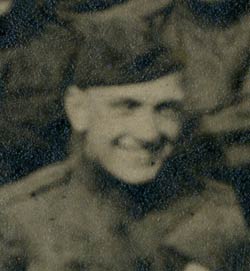 |
UPDATE OF May 12, 2010 In response to my request for information about other people in the photograph above, I was contacted by the grandsons of one of the soldiers. To find that soldier, Greg Bolle writes about his grandfather, William (Bill) W. Jamison, "... go to the 278 [at the bottom of the photograph], go up the the person over that, then one person to the left and up to the second row - you will see my grandfather. From what I was told, my grandfather was color blind and that made him good at spotting things that were camoflaged. I believe he use to spot items and take pictures of them." Bill Jamison is at left, cropped from the high-resolution download image.
Deutsches Reich Postage Stamp, 1919 (Source: Bolle)
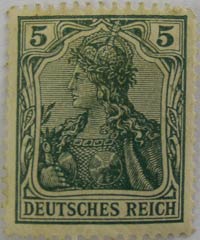 |
Improbably, the uniform that Jamison wears in the photograph is still owned by his grandsons. Now for the good part. What if you could go through the pockets of that uniform that was worn last in 1919? What would you find?
Part of the answer is at right; a five pfennig German postage stamp that was never cancelled. You can learn more about 5 pfennig stamps at the link. From the information at the link, this stamp was printed after 1902, because the phrase "Deutsches Reich" replaced "Reichspost" that year. We also know it was printed before 1916. After 1916 there were no engraving lines behind the bust of Germania. So, we clearly have a 5 pfennig German postage stamp, featuring the bust of Germania, printed 1902-1916. What is not clear is if this stamp is the genuine article, or a counterfeit printed by the U.S. or British government for use in wartime propaganda mailings. Either way, this is an interesting artifact.
More businesslike are the three receipts, below, which document equipment transactions with the quartermaster (in two cases, one Ralph W. Scott). Note there is one debit slip and two credit slips. The first debit (left) was on December 16, 1918 (which was about a month after the Armistice was signed on November 11th), and consisted of a draw of five pieces of flying clothing. Four pieces were new; his leather coat was used. The second receipt (right) consisted of a credit he received for turning in his winter flying suit, a magazine pocket for pistol ammunition, and a holster for his pistol. All on May 5, 1919. This transaction would be consistent with the post- Armistice stand-down.
Quartermaster Receipt for Flying Clothing, December 16, 1918 (Source: Bolle)
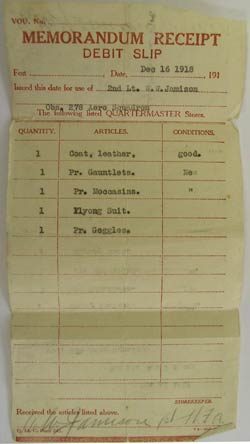 |
Quartermaster Receipt for Flying Equipment, May 5, 1919 (Source: Bolle)
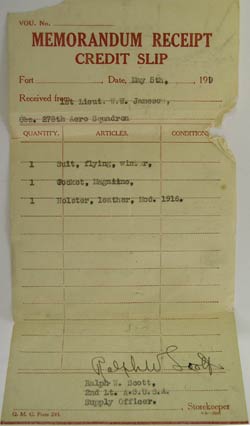 |
Below, a third (credit) receipt dated May 24, 1919. It further documents Jamison's return of equipment, including a pair of Meyrowitz Goggles No. 3. You can view a pair of Meyrowitz goggles at the link.
Quartermaster Receipt for Flying Equipment, May 24, 1919 (Source: Bolle)
 |
This receipt notes that Jamison is credited for returning one automatic pistol, calibre .45 (probably Model M1911; not clear if it was of Colt, Remington or Springfield Armory manufacture, all of which were issued near WWI), 1 magazine pocket, two extra magazines, one holster, one sweater, one leather coat, one pair of gauntlets, one pair of moccasins and the goggles.
His pistol looked something like this.
1911M Colt Automatic Pistol (Source: Web)
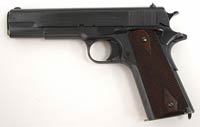 |
Also, written on the back of the receipts were a few notes that appear to be accountings of debts either owed or due from fellow soldiers. Were they gambling debts, loans for supplies or entertainment? We'll never know. Regardless, they appear to be noted in francs.
Chit for Monies Due or Owed, 1918-19 (Source: Bolle)
 |
Chit for Monies Due or Owed, 1918-19 (Source: Bolle)
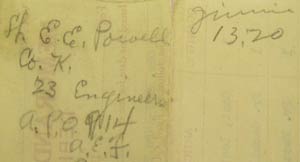 |
The largest amount is at right, bottom, where he either owes or is due 5,909 (or perhaps 59.09?) francs from a captain in what appears to be a wine debt (or the captain's name is Sauerwine; hard to read). Other figures are amended by either crossing them out (paid?), or amending the amounts owed.
Finally, a piece of paper currency. This is a Chinese 1,000 yuan note bearing a portrait of Sun Yat Sen (1866-1925). A photograph this bill with date information may be seen at the link (scroll about halfway down the page). Interestingly, the printing date for this note is given as 1942 at the link. At today's (May, 2010) exchange rates, the note is worth about $146US.
Chinese Banknote, 1,000 Yuan, Front, ca. 1942 (Source: Bolle)
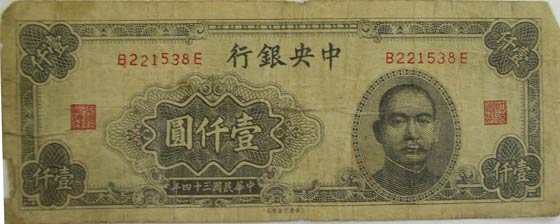 |
Chinese Banknote, 1,000 Yuan, Back, ca. 1942 (Source: Bolle)
 |
Below, the uniform worn by Bill Jamison in the photograph above. This image shows his hat and Sam Browne belt. He was an aerial observer.
Bill Jamison's WWI Uniform, Top (Source: Bolle)
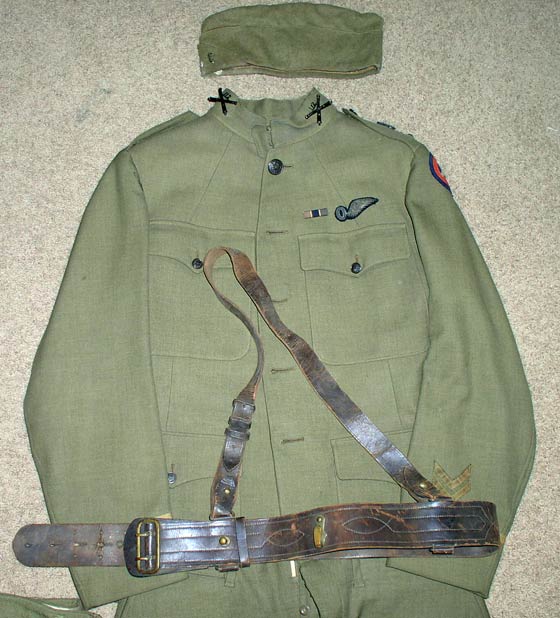 |
Below, the bottom of his uniform, with two pairs of trousers and leather calf and ankle protectors.
Bill Jamison's WWI Uniform, Bottom (Source: Bolle)
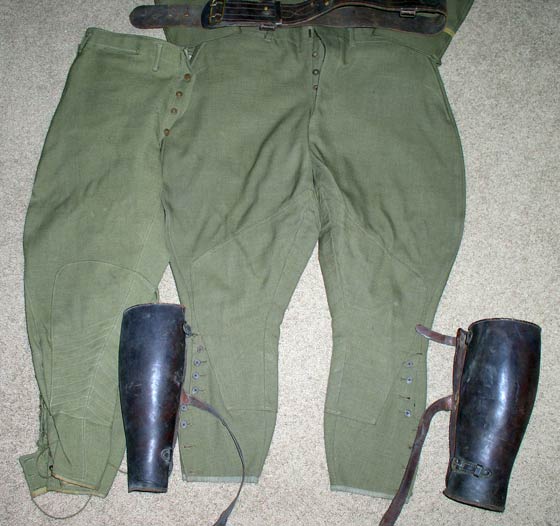 |
Below, details of the left side of his coat.
Bill Jamison's WWI Uniform, Detail (Source: Bolle)
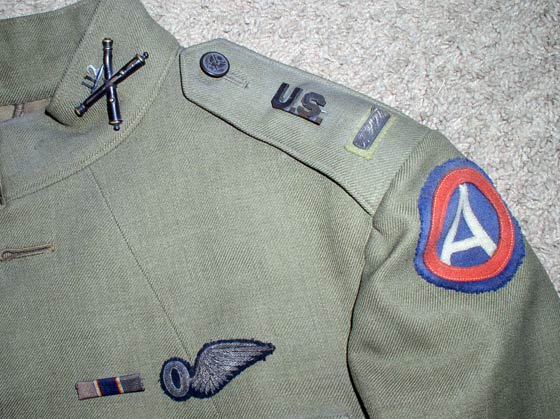 |
Bill Jamison's WWI Uniform, Leggings Detail (Source: Bolle)
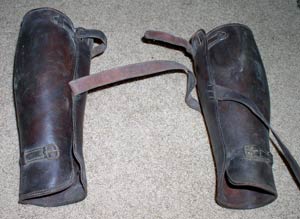 |
At right, details of the leather leggings. The short strap fastened directly to the buckle opposite. The long strap wrapped once around the calf and fastened at the lower buckle.
Among other artifacts maintained by the Bolle family is their grandfather's Collins & Co. No. 1005 machete. There are a couple of thousand Google hits for this knife style. It was commonly issued from at least WWI through WWII. This model has a green cattle horn handle. Notably, the handle on Jamison's knife is well-preserved. Many times the horn is degraded by decay and insects. The sheath is tooled and has indication of what might be a unit identification number embossed at center.The blade is knicked near the end. The brass sheath tip is cut off to allow for drainage.
Bill Jamison's Collins & Co. Machete (Source: Bolle)
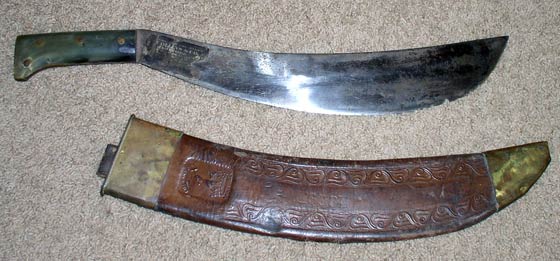 |
Stonebridge Lantern, Early 1900s (Source: Bolle)
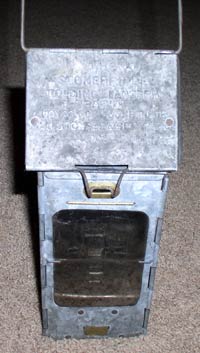 |
Also, this folding trench candle lantern, left. A description, with additional photos, of the lantern is at the link. Note the isinglass (sheet mica) window. This lantern folds flat for convenient transport in a pack. Contemporary camping stores sell similar items. They burn candles.
Bill Jamison's Leggings and Folding Buckets (Source: Bolle)
 |
At right, Jamison's Sam Browne belt, the Stonebridge lantern folded at center, plus two other artifacts in the form of two folding canvas buckets manufactured by the Planet Company, Westfield, MA. I'm not sure how long the following links will be active. If you find them inoperable, please let me know. Regardless, the canvas buckets, illustrated below, one folded, the other deployed, are described at the link. They even came with a spout in another model. The bucket measures 10" tall, 11" across the top and 9" wide across the bottom. It weighs about 1 lb. 13 oz.
Bill Jamison's Canvas Buckets (Source: Bolle)
 |
Although Jamison is not connected to the Davis-Monthan Register as either pilot or passenger, his life and artifacts are parts of the history that the Register reveals when you "peel the onion" far enough. Many thanks to the Bolle family for letting us do that by sharing their grandfather's artifacts.
---o0o---
Heisen Vignette
(Source: Chellis)
 |
To continue, here is what Thomas Chellis says about the panorama image:
"The center title to the photo states: 278th Aero
Observation Squadron 1919 Just back from France Toul Sector,
Meuse Argonne. This unit was commanded by Captain Horace
Neveille Heisen, who can be observed just above the '1919'
seated on a chair in the first row of soldiers wearing a
Sam Browne Belt, legs crossed wearing calvary boots and looking
very dapper." The image, right, shows an enlargement of him
from the parent image.
Mr. Chellis continues, "This panoramic unit photograph
was taken at the Camp Albert L. Mills debarkation center,
Long Island, New York, prior to the 278th Aero Squadron's
demobilization from service sometime between 6 July 1919
and 10 July 1919. The date and location are known because
of the presence of the British R-34 Dirigible airship in
the background. The R-34, which was an improved copy of a
similar German airship captured by the British during World
War I, made the first successful non-stop, east-to-west transatlantic
flight in history. Leaving Britain on 2 July 1919, the R-34
arrived in Mineola, Long Island, New York, on 6 July 1919,
after a flight of 108 hours with virtually no fuel left.
As the ground landing party had no experience with handling
large, rigid airships, Major E.M. Pritchard (Commanding)
jumped from the airship by parachute, successfully landed,
and personally directed the ground landing party moor the
airship, so becoming the first person to reach American soil
by air from Europe. The R-34 moored at the Hazelhurst Aviation
Field #1, located just east of Mineola and north of Camp
Albert L. Mills, for refueling and refitting prior to its
return flight to Britain, leaving the United States of America
on 10 July 1919. This was the only time the R-34 ever visited
the United States of America prior to the airship's decommissioning
from British service in 1921."
Shoulder Insignia, 3rd U.S. Army
(Source: Chellis)
 |
Further to the image, Mr. Chellis says, "...the photographic
blow-up of my grandfather's uniform intrigued me. My research
has always shown that the 278th Aiero Observation Squadron
was activated and served with the U.S. 2nd Army in France
during WWI. My research always concluded that shortly after
the Armistice the AEF's 1st U.S. Army and 2nd U.S. Army were
deactivated, leaving the rather newly created 3rd U.S. Army
as America's Army of Occupation in defeated Germany. Sure
enough, my grandfather's uniform (located at the top of the
left shoulder sleeve) contains the shoulder sleeve insignia
of the 3rd U.S. Army. The clear conclusion is that at some
point the 287th Aero Observation Squadron was transferred
from the deactivated 2nd U.S. Army to the 3rd U.S. Army to
perform occupation duties." Photo, left, of the shoulder
insignia of the 3rd U.S. Army. Corroboration for this conclusion
is found in the PDF download available in the left sidebar
of this page.
The unit photo has more significance because of the photographer.
Mr. Chellis says, "Notice the bottom left corner is
the inscription of the photo's producer: No. 665A, The
Pictorial News Co. N.Y. Researching this company I learned
that it had hired Eugene O. Goldbeck and his panoramic camera
shortly after the conclusion of WWI for the express purpose
of producing these types of photographs. Goldbeck was America's
'Dean' of early panoramic photographers. An interesting sidelight
to this photo which may be confirmed simply by cruising the
websites for Eugene Goldbeck and The Pictorial news Co."
Captain Heisen didn’t stay out of the military long,
however, because on March 15, 1920 he was appointed Major
in the Aviation Section, Signal Corps Reserve. He was
then reappointed a Captain in the Air Service, Regular Army,
September 16, 1920 and served at Bolling Field, Washington,
DC. He
transferred to Langley Field, VA for duty as a student at
the Air Corps Tactical School. He graduated in June,
1922 and remained at Langley as Commander of the Tactical
School detachment for about 4 years.
Now we find him close to his visits to Tucson. He
transferred from Langley to Boston, MA and was Commander
of the Boston Airport from March 20, 1926 to March 14, 1928. We
find him first at Tucson on October 11, 1927 on his way westbound
from Lordsburg, NM to San Diego, CA. His home base
was listed as Boston, MA. He noted in the Remarks column
of the Register, “Hello Hi”. His grandson
remarks on this, “This would not have been cuteness
or redundancy. His nickname was "Hi," a shortened
form of his surname ‘Heisen’." Through his six landings at Tucson he flew Curtiss, deHavilland and Douglas aircraft. Image, below,
is an informal military portrait taken at Kelly Field, San
Antonio, TX circa 1928.
Captain Horace N. Heisen, ca. 1928
(Source: Chellis)
 |
From March 18, 1928 to September 10, 1929 he was based at
Fort Crockett, TX, commanding the 90th Attack Squadron, 3rd
Attack Group. We find him at Tucson four times during
this period. According to his grandson, during the
period of time most of the Register entries were made by
him (10/11/1927-11/8/32), he was flying border patrol duties
with the squadron he led.
Based alternately at Kelly Field and Crockett Field they
would fly from these northern locations to Ft. Bliss, El
Paso, TX (Biggs Airfield). From there they would fly
southeast to Marfa, TX, where there was a US Army Airfield,
and then patrol the border west for Mexican bandits all the
way to Rockwell Field, CA (now the North Island Naval Station,
Coronado, CA). During this time there were extensive
raids by Mexican ex-revolutionaries/bandits involved in cattle
rustling, robbery, and general mayhem along the US-Mexican
border. His squadron's planes, usually of the observation
type, flew armed and had several air-to-ground engagements
during the time of the Register.
Informal image, below, of Horace Heisen's two daughters
Hilda (L) and Paula Heisen taken about 1934.
Hilda (L) and Paula Heisen, His Daughters
(Source: Chellis)
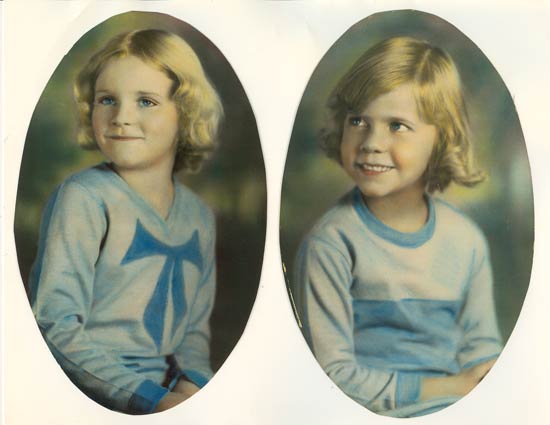 |
He was moved to Rockwell Field, CA from June 21, 1932 to
October 21, 1933 where he commanded the 32nd Bombardment
Squadron, and then carried out several other smaller assignments
until he was transferred to Moffett Field, Sunnyvale, CA
on October 25, 1935. He became ill after three months
and was transferred to a hospital in San Francisco.
Captain Heisen died at age 42, on March 23, 1936, at Letterman
General Hospital, San Francisco, CA, as a result of pancreatic
cancer. Because of the wasting nature of his disease,
his girls were kept from observing his passing. All they
knew was that dad had died and their mom was left with getting
the family through the Great Depression.
Heisen's military
records apparently were destroyed during the July 12, 1973
fire at the National Personnel Records Center in St. Louis,
Missouri. Nonetheless, the information provided to us by
his family more than compensates, and makes this page one
of the most interesting and insightful (and gratifying to
write) on this site.
---o0o---
Dossier 2.2.103
THIS PAGE UPLOADED: 01/29/07 REVISED: 02/16/07
|
